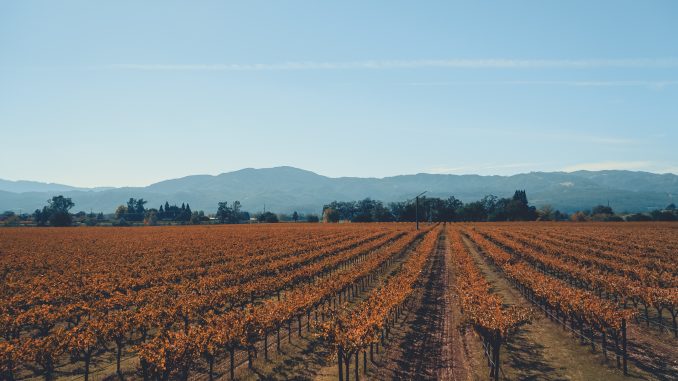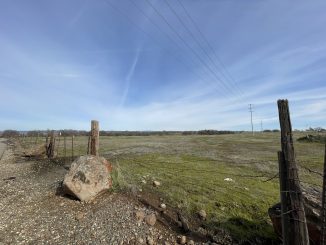
This story is produced by the award-winning journalism nonprofit Capital & Main, and co-published here with permission.
The Butterfly Effect
Ten years ago I met a lepidopterist, a fanatic for butterflies. During butterfly season, Stuart Weiss, who has a background in conservation ecology and a PhD from Stanford University, would go clambering through the Santa Clara Mountains in search of monarchs, checkerspots and other favorite butterflies on their migratory path to Mexico. And then he realized something that would change his life: The process of transforming a caterpillar into a butterfly was very similar to the ripening of a wine grape.
The same two ingredients—heat and light—are key to catalyzing both the metamorphosis of a caterpillar into a butterfly and the emergence of a tiny kernel on the tip of a grapevine into a plump and juicy wine grape. And with that insight was born Weiss’ thriving viticulture business, Viticision, which consults with wine growers about how to adapt their terrain and growing patterns to what was becoming clear back then, and ever-more dramatically so today—how much the climate is changing in Napa and Sonoma counties, the heart of America’s multibillion dollar wine industry.
At the time when I talked to Weiss just over a decade ago, many wineries in California and elsewhere were discounting the impacts of climate change due, largely, to an unwillingness to confront its terrifying implications for highly lucrative wine varietals. But Weiss came to wine from butterflies. As he put it to me, comparing his study of butterflies to his study of vineyards, “We’re keeping the verbs the same and we’re changing the nouns.”
He didn’t have a stake in the rise or fall of a Cabernet or a Pinot or a Merlot. Weiss applied his knowledge of a science known as phenology—aka, studying the factors contributing to a plant or animal’s development. Which is all about temperature, moisture, sunlight—in other words, every component of the atmosphere that is now undergoing massive, hectic and accelerating change.
I had never heard of phenology before I interviewed Weiss, but now it seems it’s a term that all journalists covering climate change, or anyone contemplating its many implications, might want to include in their lexicon. It applies everywhere we turn: From the ways in which bird mating patterns are changing due to altered temperatures to the egg-laying patterns of amphibians to the preternaturally warm winters experienced by tree-fruit growers to the fertile fields of Napa and Sonoma counties, phenology is the discipline of our time. It enabled Weiss, along with many other pioneering scientists, to see from the disruption of ecological systems what was coming and what is unavoidably clear today: That time is ticking on Napa and Sonoma’s legendary Cabernet Sauvignon, as it is for many other wine varieties that have thrived in the temperate climates of California.
I love reading trade journals. They’re not exactly literature, but if you want to know what’s going on in an industry, the best thing is to figure out what people in the industry are reading. And so it came as an eye opener to realize that while we wine drinkers may be reading the weather report for a glimpse into the coming week’s climate, what wine growers are guaranteed to be reading (in addition to the weather report) are the latest updates to the Winkler Scale. The Winkler Scale was devised at UC Davis to identify the climatic zones most suitable to different wine varieties, rated according to the frequency of temperatures above 50 degrees Fahrenheit in the months between April and October, the key wine grape growing season. The scale goes from Region I, the coolest, to Region V, the hottest. Napa Valley was until recently predictably and comfortably in the Region III and IV range—moderate, Mediterranean, ideal for its abundant grape plantings.
But today, after a temperature rise of 2.3 degrees Fahrenheit since 1895—and less moisture in the atmosphere due to drought—the Valley is headed toward Region V, which could forever alter the conditions for the counties’ beloved Cabernets. New (for California) varieties from Spain, Portugal and Croatia, well adapted to those warmer and drier climates, are already being grafted onto Napa vines, and could soon enough be replacing those treasured Cabs. The journal of the International Viticulture and Enology Society, OenoOne—in whose pages I learned about the Winkler Scale—suggests that the rising temperatures and other alterations from the 50 year “norm” suggests we’re getting “close to the tipping point” of Napa’s most celebrated varietals. Meanwhile, prime vineyard territory is heading steadily north, which is why you may be finding more and more bottles at your local wine store emanating from what used to be ever-cold and rainy Oregon and Washington.
Weiss embodies the cross-disciplinary nature of what it means to be covering climate change. Start with a butterfly and you end up with the Winkler Scale.
The weed effect: Roundup’s return?
Climate change is like a lesson in the butterfly effect—that theory drawn from chaos theory that even one small perturbation, like the flutter of a butterfly, can send off a cascade of impacts and alter future events, on a small or large scale. Let’s talk, for example, about weeds—all those weeds that are now bursting from the soil in the vineyards across Napa and Sonoma counties due to the deluge of rain in January and February, and competing with all those grapevines for nourishment.
The combination of warm weather and rain is like an all-you-can-eat invitation for unwanted grasses. Too much water is, of course, the flip side of not enough water, one of the classic symptoms of our disrupted climate. It was the rapid succession and intensity of the storms of January and February that scientists ascribe to the impacts of climate change.
Air that is hotter holds more moisture, so when it falls it comes down in a torrent. Which becomes highly relevant to the question of how much of a potentially dangerous quantity of glyphosate, the key ingredient in Monsanto’s best-selling chemical herbicide Roundup, is poured onto vineyards. (Monsanto is now owned by the German agri-pharma-chemical giant Bayer.) Winemakers in Napa and Sonoma counties applied 33,000 pounds and 48,000 pounds, respectively, of glyphosate last year. Dozens of lawsuits allege that glyphosate, which is included on California’s Prop. 65 list of carcinogenic chemicals, contributed to cancers among numerous farmworkers, and is currently under review by the EPA.
For journalists and anyone else, it is worth being aware that disruptions to the atmosphere above our heads may lead to more toxins below our feet. What will growers do to contend with the bounty of weeds? And to complete the climate circle: In early February, U.S. Right to Know released a report identifying the public relations companies associated with Monsanto/Bayer’s attacks against scientists and journalists reporting on Roundup’s cancer risks, and the same company’s similar attacks against journalists and scientists writing about climate change.




Be the first to comment